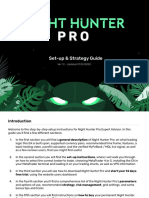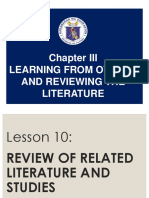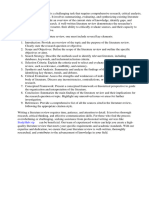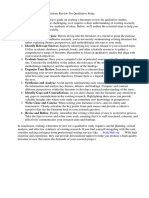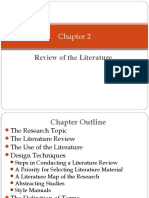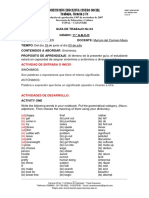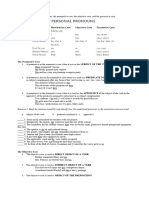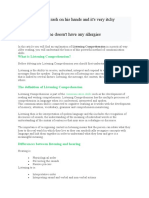Literature Reviews
Literature Reviews
Uploaded by
Myrell SugaboCopyright:
Available Formats
Literature Reviews
Literature Reviews
Uploaded by
Myrell SugaboCopyright
Available Formats
Share this document
Did you find this document useful?
Is this content inappropriate?
Copyright:
Available Formats
Literature Reviews
Literature Reviews
Uploaded by
Myrell SugaboCopyright:
Available Formats
Literature Reviews
What is a literature review?
A literature review is a description, summary, and critical evaluation of scholarly works on a certain
topic. A literature review combines both summary (a recap of important information) and synthesis (a
reorganization of that information which reflects your approach to a research problem). You may be
asked to write a literature review on a certain topic for a class, or you may need to include a literature
review as one part of a research paper, thesis, or dissertation.
What is the difference between an academic research paper and a literature review?
The goal of a literature review is to summarize and synthesize the previous research and arguments of
other scholars, without adding new contributions.
The goal of a research paper is to develop a new argument, and typically includes some form of data
collection and analysis. A research paper usually includes a literature review as one of its components
(often labeled as the “Background” or “Theoretical Background” section).
Why are literature reviews necessary?
A literature review demonstrates the author’s understanding of the existing research on a topic and the
author’s ability to relate previous research to their own questions or ideas. Literature reviews provide
solid background for a research paper’s investigation, allowing the author to situate their own question
within the larger academic conversation on a given topic. A literature review with sufficient breadth and
depth reflects the credibility of the author and the author’s research.
Literature reviews address common beliefs or debates on a topic, offer definitions and frameworks
necessary to understand a topic, and incorporate recent (and sometimes historical) scholarship on that
topic. Because they summarize and synthesize literature on a specific topic, literature reviews can
function as a general overview to that topic for readers.
Types of literature reviews
You can adopt different approaches to the literature review depending on the type of analysis
underpinning your research.
Argumentative review: This type of literature review examines literature in a selective way in order to
address a specific argument, assumption, or philosophical standpoint that is firmly established in the
literature, typically with the goal of developing an alternative viewpoint.
Integrative review: This type of literature review generates new frameworks and perspectives on a
topic. This type of literature review includes all known studies addressing a specific question or
hypothesis.
Historical review: This type of literature review focuses on examining research throughout time, often
starting with the first time the topic emerged in the literature and then examining how approaches to
that topic have changed over time. The goal of this type of review is to provide historical context for the
research question.
Methodological review: This type of literature review does not focus on scholars’ findings but instead
on how they came to their conclusions (the methods they used to reach their findings). This type of
review is useful for exploring the validity of different types of methods used to examine a given topic
and provide guidance about which methods should be used in the future.
Systematic review: This type of literature review provides an overview of evidence addressing a specific,
clearly defined research question. It incorporates standardized methods for identifying and reviewing
the literature that should be clearly explained in the literature review, with the goal of including all
relevant studies on the given topic.
Theoretical review: This type of literature review explores the different theories used to approach a
given topic, including the pros and cons of different theories, the relationships between theories, and
the ways that different theories have been tested and investigated.
Steps to complete a literature review:
1. Determine the focus of your literature review. The focus of your literature review should be
guided by your thesis statement (the main claim or argument you plan to make in the paper).
Avoid topics that are too broad or too narrow. When your topic is too broad, you may have too
much material to work with and find it difficult to create focus in the paper. When your topic is
too narrow, you may struggle with finding enough literature to review.
2. Find literature to review that is related to your research topic. This can include books, journal
articles, news articles, websites, etc. depending on the research topic. Literature reviews
typically include secondary sources rather than primary sources (e.g. if you are writing a paper
about the Declaration of Independence, your literature review would include books and articles
about the Declaration of Independence, rather than the contents of the Declaration of
Independence itself). Good places to look for sources are: libraries, online databases, course
syllabi, Google Scholar, and the references section of relevant books and articles. Make sure to
judge the quality of your sources (e.g. make sure that articles come from reputable journals or
that websites are associated with reputable organizations). Wikipedia is not considered a high-
quality source, but many Wikipedia articles do have sources listed in the references section that
can be useful. If you need to, make contact with University Libraries’ subject librarians, so they
can assist you in locating databases, journals, and articles relevant to your research.
3. Evaluate the contribution of each source. Determine the main point or argument of each
source. Consider how the source relates to your own research question. Then determine which
sources are most relevant and which sources should be included in your review. Depending on
the type of review you are doing, you may not need to include every source you found on a
given topic, especially if multiple sources make the same or similar point. Consider page and
word limits as you determine which and how many sources to include. If you are conducting an
integrative or systematic review, you will include all sources that fall within your specified
research parameters (something that is determined before you start searching for literature). At
this stage, it can be helpful to create an annotated bibliography to keep track of the
contributions of different sources.
4. Synthesize. Determine how the sources relate to each other and to your own research. Identify
common and/or important themes, disagreements or different points of view among scholars,
gaps in the research, and any apparent issues with methodology or conclusions. Create an
outline to help organize your ideas before you start writing. You may find that certain sources
connect directly, while others have less-obvious links; review the following strategies for
grouping together and discussing multiple sources.
a. Strategies for synthesizing literature:
i. Thematic: Group ideas according to theme. Show how different sources are
related thematically. Consider common themes that are addressed in the
literature, and how different scholars have approached those themes.
ii. Chronological: Group ideas by periods of time. Consider how scholarly methods
and/or scholarly thinking have changed over time.
iii. Methodological: Group ideas by method. Identify different methods that have
been used to address the issue and consider whether different methods have
led to different conclusions.
5. Write the literature review. Start with an introduction that describes the main topic and
research question. Use the outline you developed in step 4 as a guide as you write the body of
the literature review. Importantly, do not just write an isolated paragraph for each source. Make
sure to make connections across different sources to create a coherent discussion on the topic.
Conclude by explaining how your own research question or argument fits into the scholarly
discussion. This allows you to create a transition from the literature review to the specifics of
your own study if necessary (e.g. your methods and analysis).
Helpful tips:
1. Look at examples of literature reviews by scholars in your field to get a sense of what a
literature review entails.
2. Be flexible. Writing a literature review is not a linear process. After you’ve started writing, you
may find that you need to go back and find more literature to review or need to re-evaluate
literature you’ve already found. You may need to change your synthesizing strategy or
reorganize your sources.
3. Keep in mind that the goal of the literature review is to explain established research and situate
your own research questions within the literature. Save your original ideas and analyses for
other sections of the paper.
4. Lit reviews should be clearly signposted via introductions, transitions, and a
conclusion/restatement that brings the threads together. Ensure that the reader knows the
purpose and structure, especially in longer lit reviews.
5. Avoid repetition. If three scholars make the same or similar point, explain it one time and then
cite all three scholars in the citation.
6. Avoid plagiarism by citing all sources. Remember that direct quotes and paraphrases need to be
cited. Any ideas that you did not come up with yourself must be cited. Literature reviews will
have a lot of citations, but should not consist solely of citations. Fully explain each citation and
make clear connections between sources.
7. Make use of a reference management system, such as Zotero or Mendeley, as it will make your
writing easier throughout your graduate process.
You might also like
- Night Hunter Pro - Setup GuideDocument75 pagesNight Hunter Pro - Setup GuideMk Dias100% (1)
- Cairn of The Winter KingDocument32 pagesCairn of The Winter KingKyouko Oshima100% (10)
- FSM Haccp Butter ChickenDocument26 pagesFSM Haccp Butter ChickenAYMAN ZEHRANo ratings yet
- How To Write A Literature ReviewDocument21 pagesHow To Write A Literature ReviewMilo90% (10)
- Monica Lewinsky and ShameDocument26 pagesMonica Lewinsky and ShameTracy EverbachNo ratings yet
- Writing A Literature ReviewDocument16 pagesWriting A Literature ReviewChristian TaguinodNo ratings yet
- What The Bible Says About Child Training ExcerptsDocument12 pagesWhat The Bible Says About Child Training Excerptsfourbzboysmom100% (1)
- Check Out My 'Advanced Culture-Fair IQ Test' Results From The IQ Comparison SiteDocument4 pagesCheck Out My 'Advanced Culture-Fair IQ Test' Results From The IQ Comparison SiteMia SercoNo ratings yet
- Review of LiteratureDocument8 pagesReview of LiteratureManar Mahmoud100% (1)
- 9literature ReviewDocument12 pages9literature ReviewQurat ul AinNo ratings yet
- Literature Review InterpretingDocument8 pagesLiterature Review InterpretingKawtarNo ratings yet
- Raguindin, Lansang Literature PowerpointDocument23 pagesRaguindin, Lansang Literature Powerpointsoleilramirez217No ratings yet
- Lesson 3Document12 pagesLesson 3ERLINDA PALACIONo ratings yet
- Chapter 2 - Literature Review PDFDocument15 pagesChapter 2 - Literature Review PDFasyikin zulkifli100% (1)
- Review of Literature - StructureDocument5 pagesReview of Literature - StructureManar MahmoudNo ratings yet
- RRL PR1Document50 pagesRRL PR1Mark Froilan NamiaNo ratings yet
- Literature Review PartsDocument5 pagesLiterature Review Partsfrvkuhrif100% (1)
- Lit ReviewDocument22 pagesLit ReviewCindy Lou LawasNo ratings yet
- Reviewing LiteratureDocument11 pagesReviewing LiteratureFitki SuyitnoNo ratings yet
- How To Present Literature ReviewDocument7 pagesHow To Present Literature Reviewgvytgh3b100% (1)
- RWS ReviewerdwtdDocument19 pagesRWS ReviewerdwtdJazmin BosqueNo ratings yet
- How To Write A Literature ReviewDocument5 pagesHow To Write A Literature ReviewAli AlexisNo ratings yet
- Steps To Writing An Effective Literature ReviewDocument8 pagesSteps To Writing An Effective Literature Reviewea4gaa0g100% (1)
- What Is A Literature Review? Further ReadingDocument2 pagesWhat Is A Literature Review? Further ReadingMia SamNo ratings yet
- How To Write A 500 Word Literature ReviewDocument8 pagesHow To Write A 500 Word Literature Reviewdazelasif100% (1)
- The Literature Review 2019Document30 pagesThe Literature Review 2019Dari ThangkhiewNo ratings yet
- How To Do A Literature Review (Describe The Steps)Document5 pagesHow To Do A Literature Review (Describe The Steps)ea59j0hqNo ratings yet
- Characteristics of A Good Literature ReviewDocument7 pagesCharacteristics of A Good Literature Reviewdrnpguwgf100% (1)
- Chapter III Lesson 10 Review of Related Literature and Studies PDFDocument26 pagesChapter III Lesson 10 Review of Related Literature and Studies PDFJames Angelo MojaresNo ratings yet
- Review of RRL2Document40 pagesReview of RRL2JohnmarvinDalupangDelaCruzNo ratings yet
- Steps of Performing Literature ReviewDocument7 pagesSteps of Performing Literature Reviewc5qj4swh100% (1)
- A Literature Review Is A Specific Type of Research Paper That Focuses On Published Literature On A Given TopicDocument4 pagesA Literature Review Is A Specific Type of Research Paper That Focuses On Published Literature On A Given TopicAbdul Basit Ali TahirNo ratings yet
- Writing The Literature Review: Literatur KimiaDocument21 pagesWriting The Literature Review: Literatur KimiaRissahNo ratings yet
- Chapter 6 Writing A Book Review or Article CritiqueDocument7 pagesChapter 6 Writing A Book Review or Article CritiqueNeil Henessy Casuncad CuareNo ratings yet
- Literature Review Example MbaDocument4 pagesLiterature Review Example Mbaaflspfdov100% (1)
- Literature ReviewDocument12 pagesLiterature Reviewelinatheint.uumNo ratings yet
- Literature Review Article StructureDocument6 pagesLiterature Review Article Structurec5p6e5z1100% (1)
- Literature ReviewDocument6 pagesLiterature Reviewsoleilramirez217No ratings yet
- CORE 001 4th Quarter - Lesson 11Document15 pagesCORE 001 4th Quarter - Lesson 11NatsumiGraceNo ratings yet
- What Should Include in Literature ReviewDocument6 pagesWhat Should Include in Literature Reviewwtdcxtbnd100% (1)
- How To Organize Articles For Literature ReviewDocument7 pagesHow To Organize Articles For Literature Reviewcmaqqsrif100% (1)
- Argumentative ReviewDocument7 pagesArgumentative ReviewJan Rey LerinNo ratings yet
- Untitled Document 13Document4 pagesUntitled Document 13soleilramirez217No ratings yet
- How To Write A Literature Review For Qualitative StudyDocument6 pagesHow To Write A Literature Review For Qualitative StudykcjzgcsifNo ratings yet
- Different Parts of A Literature ReviewDocument5 pagesDifferent Parts of A Literature Reviewaflstfcap100% (1)
- Review of Related LiteratureDocument2 pagesReview of Related LiteratureAivannah Marie LopenaNo ratings yet
- Lesson 3 - Reading On Related StudiesDocument5 pagesLesson 3 - Reading On Related StudiesJeiel Collamar GozeNo ratings yet
- Literature Review CategoriesDocument7 pagesLiterature Review Categoriesafmzslnxmqrjom100% (1)
- Search For Relevant LiteratureDocument2 pagesSearch For Relevant LiteraturesasoNo ratings yet
- Types of Literature Review in ResearchDocument8 pagesTypes of Literature Review in Researchaflskfbue100% (1)
- How Do I Write A Literature Review OutlineDocument8 pagesHow Do I Write A Literature Review Outlinec5kgkdd4100% (1)
- Steps of Literature Review PDFDocument4 pagesSteps of Literature Review PDFgvzcrpym100% (1)
- Steps Involved in Writing A Literature ReviewDocument4 pagesSteps Involved in Writing A Literature Reviewgw1g9a3s100% (1)
- Literature ReviewDocument12 pagesLiterature ReviewumerNo ratings yet
- Describe The Process of Literature ReviewDocument8 pagesDescribe The Process of Literature Reviewelrurbrif100% (1)
- RWSMod3 Week 3 Q2Document9 pagesRWSMod3 Week 3 Q2Kate leeNo ratings yet
- Lit ReviewDocument4 pagesLit ReviewMeg ObpNo ratings yet
- Write A Literature ReviewDocument11 pagesWrite A Literature ReviewYakop SupriyadiNo ratings yet
- Literature Review SubsectionsDocument6 pagesLiterature Review Subsectionsutwvgkxgf100% (1)
- Literature Review Part of Research PaperDocument4 pagesLiterature Review Part of Research Paperc5qd4nn8100% (1)
- How To Write Literature Review FasterDocument7 pagesHow To Write Literature Review Fasteraflslwuup100% (1)
- What Type of Literature Reviews Are ThereDocument7 pagesWhat Type of Literature Reviews Are Thereafmzmrigwaeera100% (1)
- What A Literature Review Consist ofDocument5 pagesWhat A Literature Review Consist ofafmzrxbdfadmdq100% (1)
- Chapter 2Document16 pagesChapter 2kasimNo ratings yet
- Steps To Take When Writing A Literature ReviewDocument4 pagesSteps To Take When Writing A Literature Reviewea84k86s100% (1)
- Understanding Essay Writing: A Guide To Writing Essays By Someone Who Grades ThemFrom EverandUnderstanding Essay Writing: A Guide To Writing Essays By Someone Who Grades ThemRating: 4 out of 5 stars4/5 (4)
- Thesis Coffee ShopDocument4 pagesThesis Coffee Shopcrystalwilliamscleveland100% (2)
- David C Cook New Releases Spring 2024Document43 pagesDavid C Cook New Releases Spring 2024Omar Zenteno-FuentesNo ratings yet
- Marketing Communications - Module 4 NotesDocument8 pagesMarketing Communications - Module 4 NotesadamNo ratings yet
- Institución Educativa Centro Social Trabajo, Ciencia y Fe: Actividad de Entrada O InicioDocument3 pagesInstitución Educativa Centro Social Trabajo, Ciencia y Fe: Actividad de Entrada O InicioGuery Ludh Piñeros GutierrezNo ratings yet
- CapstoneDocument3,306 pagesCapstoneVan Sj TYnNo ratings yet
- 9 3 2023-DUCY Minutes-of-MeetingDocument5 pages9 3 2023-DUCY Minutes-of-MeetingJunlie Gomez CabatinganNo ratings yet
- (B29) LAW 104 - Amedo v. Rio (No. L-6870)Document3 pages(B29) LAW 104 - Amedo v. Rio (No. L-6870)m100% (1)
- Longitudinal Surface Acoustic WavesDocument176 pagesLongitudinal Surface Acoustic WavesStanislovas SajauskasNo ratings yet
- The Neverhood ChroniclesDocument57 pagesThe Neverhood ChroniclesCarolina Silva RodéNo ratings yet
- Cases of Personal PronounsDocument2 pagesCases of Personal PronounsAsle Joyce Pameroyan FloresNo ratings yet
- UNIPORT Post UTME Past Questions For Arts Social and Management ScienceDocument47 pagesUNIPORT Post UTME Past Questions For Arts Social and Management ScienceNzekwe ChideraNo ratings yet
- State Racism in Franco's Spain.Document5 pagesState Racism in Franco's Spain.Mr SanchezNo ratings yet
- Sebaca National High SchoolDocument3 pagesSebaca National High SchoolJulius Azcuna100% (1)
- Maths Formula Pocket Book Maths Formula-Page62Document1 pageMaths Formula Pocket Book Maths Formula-Page62Ernie LahaylahayNo ratings yet
- Soal Latihan Command and RequestDocument3 pagesSoal Latihan Command and RequestdewiNo ratings yet
- Confession Under Indian Evidence Act, 1872: Uil, Panjab University Regional Centre, LudhianaDocument32 pagesConfession Under Indian Evidence Act, 1872: Uil, Panjab University Regional Centre, Ludhianagourav bansalNo ratings yet
- Prof Ed Pe-Board V1Document19 pagesProf Ed Pe-Board V1Gerry San JoseNo ratings yet
- Listening ComprehensionDocument5 pagesListening ComprehensionShara TauladaniaNo ratings yet
- A. Count and Write The Number of Objects in Numerals and WordsDocument10 pagesA. Count and Write The Number of Objects in Numerals and Wordse_awinNo ratings yet
- Software Engineering Chapter 1Document31 pagesSoftware Engineering Chapter 1nitin guptaNo ratings yet
- 2 Final To Print CV Time ManagementDocument9 pages2 Final To Print CV Time ManagementTyrNo ratings yet
- The True Ten Commandments - WPS OfficeDocument5 pagesThe True Ten Commandments - WPS Officefulgence njauNo ratings yet
- Operations Pris NewDocument11 pagesOperations Pris NewAyanleke Julius OluwaseunfunmiNo ratings yet
- Use Equals Sign To Determine Missing Numbers Algebra Level 3 Worksheet - Ver - 3Document13 pagesUse Equals Sign To Determine Missing Numbers Algebra Level 3 Worksheet - Ver - 3Fatima AliuNo ratings yet
